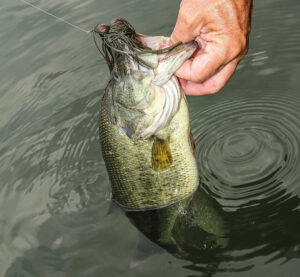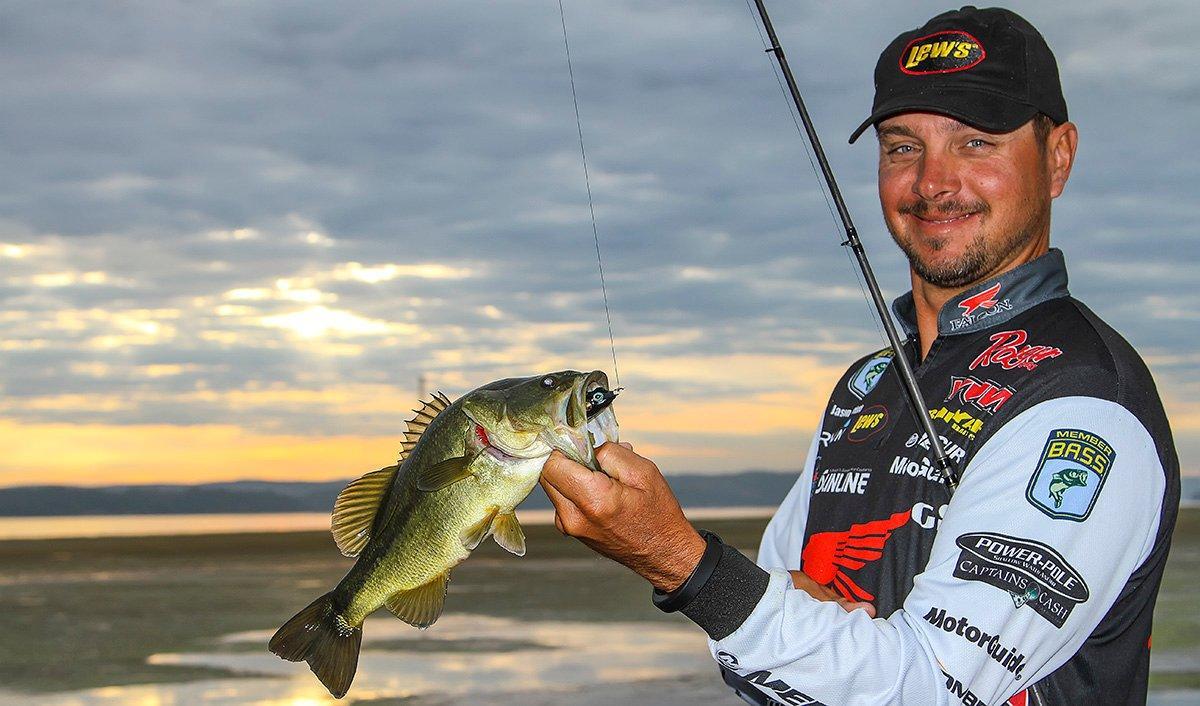Bass fishing’s full of exceptions to rules. Among them: Fall finds the fish running into the creeks to gorge on shad. Many do, but not all of them.
Throughout many southern lakes, when main lake grass beds grow dense and broad, significant masses often linger well into winter. Packed with crawfish and, more importantly, shad, these fields of milfoil and/or hydrilla often persuade bass to forego that creek trip.
Moreover, when fish in northern latitudes shift to deeper winter refuges, a lot of their southern kin fare well by parking in that heat-holding, food-rich vegetation.
As Alabama guide Jimmy Mason noted, cooler water temperatures and fall winds break up mats of grass and displace them. This can congregate bass in smaller areas of predictable fishing.
Case in point: on a late fall trip to Lake Guntersville, I watched boil after boil bespeak the frantic pursuits of bass pushing threadfin and gizzard shad around the big holes in a late season grass mat. Similarly, the occasional swirls and busts in a Lake Okeechobee grass bed indicated a spike in feeding, during early winter warming trends.
As the season wears on, we often find some of the topped-out presence diminishing into surface-tickling grass stands – lighter on the top, but still plenty of bass harboring density below. Certain scenarios may find a fracturing affect in which mats yield portions of their outer edges to seasonal die off. This leaves a spotty outer zone that’s ripe for particular tactics.
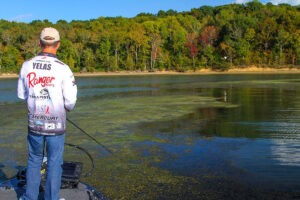
FIND THE FISH
Let a significant cold front blow through the area and you can bet the “bluebird” conditions on the backside will drive any bass orienting to the grass deep into its sanctuary. That’s more of a retreat from high pressure and intense sunlight.
During stable conditions though, most fish will set up closer to the edges in classic feeding positions.
Bassmaster Elite Series pro Jason Christie said he likes main lake grass beds because they link the bass to a discernible area. A mat may be 100-plus yards long, but the visual reference is a lot less random than looking for fish that are looking for shad all throughout the creek’s open water.
According to Christie, creeks may see intervals of aggressive late-fall schooling, but this can quickly turn into a lot of ghost chasing. Conversely, grass fish tend to be more home stationary.
“The fish usually aren’t spread out all along a mat – there are usually a few key areas where they’ll school up,” he said. “If you can find those areas, you’ll usually catch several fish.”
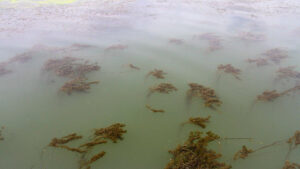
FLW Tour pro J.T. Kenney typically starts with the outer rim of a grass bed and works progressively inward, as conditions dictate.
During an Okeechobee outing, Kenney was graphing scattered hydrilla that had pulled back from the matting of previous months. The good news-bad news reality – the area held tons of potential, but it was a big, big area.
“What makes the remaining grass so good (for late fall-winter) is that any fish that wants to be in thick cover – that’s where he’s going to be,” Kenny observes. “The part I hate is just floating around in this big area and casting until you find them. It’s boring, but there’s no other way.
“Usually, the sweet spot is about the size of a football field in one of these giant areas and that’s where it seems all the fish will be. Not that you can’t catch a fish here and there. Usually, it seems that you’ll troll around and fish, and then you’ll catch a couple and put a waypoint on that spot.”
KEY POINTS
Such concentrated productivity typically correlates to something interesting below. This might be large open areas concealed by depth and/or water color; rocks, stumps, laydown, etc. In any case, consider a flurry of activity your cue to pole down and work the area.
When judging a grass bed, FLW Tour pro Jay Yelas looks for points, turns, hooks and any contour change that creates an edge or ambush spot for a bass merits particular attention. Kenny likes boat cuts where water flows between mat segments for significant potential. In warm southern lakes, where prespawn staging can start as early as November-December, fish looking to feed benefit from thick cover and current-born food delivery.
Mat makeup matters too and Kenney seeks a variety of vegetation, particularly large, established clumps of pennywort that can kill holes in the hydrilla and leave spacious caverns below. Also, drifting brown rafts killed by aquatic weed spraying will wedge into live grass and do the same.
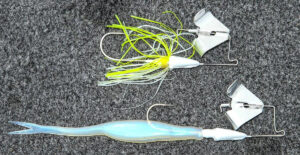
TOP TACTICS FOR COLD GRASS
- Heavy Handed — Flipping jigs in looser grass, or driving a beaver style plastic into thicker growth with an ounce to 1 ½-ounce weight will seek out bass effectively. Match your trailers and flipping/punching bodies to prevailing conditions. Active periods, favor the quick fall of a streamlined plastic, while the greater drag of a bulkier plastic (i.e. chunk trailers) slows the bait for lethargic fish.
- All the Buzz — When late fall fractures the edges of grass beds, Mason’s keen to throw a small buzzbait. Mimicking the smaller shad common to this season, the bait easily traverses the tattered clumpy patches. To deepen the ruse, Mason might remove the bait’s skirt and add a pearl YUM Breaking Shad.
- The Swim Team — In stable weather, when the fish are chewing, Yelas likes an aggressive presentation with a 5-inch Yamamoto Swimbait on a 6/0 EWG hook or a 5-inch Swim Senko on a 5/0 EWG hook. Targeting lanes and gaps in the grass, he’s trying to trigger reaction bites.
- Hop to It — Warming trends might bring the topside game into play. Dense matting will be minimal this time of year, so bass can easily track and target these amphibian imposters. Bring your frog across the grass and pause it for deadly vulnerability at the edge of a blow hole before continuing.
- Perimeter Patrol — Kenny’s top choice for aggressively working the edge of a grass bed is his homemade bladed swim jig with a Gambler Big EZ swimbait trailer. Also productive are lipless crankbaits (snag-n-rip), spinnerbaits and even jerkbaits like a Rattlin Rogue.
